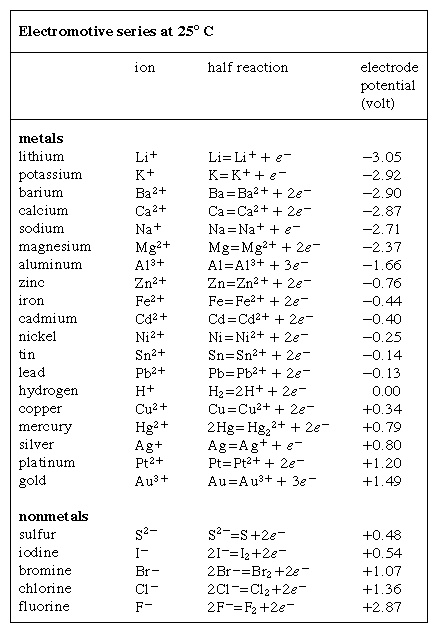electromotive series
chemistry

 listing of chemical species (atoms, molecules, and ions) in the order of their tendency to gain or lose electrons (be reduced or oxidized, respectively), expressed in volts and measured with reference to the hydrogen electrode, which is taken as a standard and arbitrarily assigned the voltage of zero. At the hydrogen electrode, an aqueous solution containing hydrogen in its oxidized form (the hydrogen ion, H+) at a concentration of one mole per litre is maintained at 25° C (77° F) in equilibrium with hydrogen in its reduced form (hydrogen gas, H2) at a pressure of one atmosphere. The reversible oxidation–reduction half reaction is expressed by the equation 2H+ + 2e- ⇌ H2, in which e- represents an electron. The electrode potentials of several elements are shown in the Table-->
listing of chemical species (atoms, molecules, and ions) in the order of their tendency to gain or lose electrons (be reduced or oxidized, respectively), expressed in volts and measured with reference to the hydrogen electrode, which is taken as a standard and arbitrarily assigned the voltage of zero. At the hydrogen electrode, an aqueous solution containing hydrogen in its oxidized form (the hydrogen ion, H+) at a concentration of one mole per litre is maintained at 25° C (77° F) in equilibrium with hydrogen in its reduced form (hydrogen gas, H2) at a pressure of one atmosphere. The reversible oxidation–reduction half reaction is expressed by the equation 2H+ + 2e- ⇌ H2, in which e- represents an electron. The electrode potentials of several elements are shown in the Table--> . Conflicting conventions have been used for the signs of these potentials; those shown in the Table-->
. Conflicting conventions have been used for the signs of these potentials; those shown in the Table--> generally agree with the recommendations of an international conference in 1953.
generally agree with the recommendations of an international conference in 1953.By subtracting one half reaction (and its potential) from another, the tendency of the resulting complete chemical reaction to occur may be determined; for example, the half reactions for copper and zinc may be combined to show that the reaction Cu2+ + Zn ⇌ Cu + Zn2+ has a potential of -1.10 volts. In conformity with the 1953 convention, the negative value of the voltage indicates that this reaction proceeds spontaneously from left to right as written; that is, metallic zinc dissolves in a solution of copper(II) ions to form metallic copper and to set free zinc(II) ions in the solution.
- Pangani River
- Pangasinan
- Pangea
- Pangeran Dipo Negoro
- Pan-Germanism
- Pangkalpinang
- Pangkor Engagement
- pangolin
- Panguitch
- Panguna
- Panhard, René
- Panhellenic Socialist Movement
- Pan, Hermes
- panic
- panicum
- Panihati
- Panikkar, Kavalam Madhava
- Panin, Nikita Ivanovich, Graf
- Panipat
- Panizzi, Sir Anthony
- Panjgūr
- Panjnad River
- Panj River
- Pankhurst, Dame Christabel Harriette
- Pankhurst, Emmeline